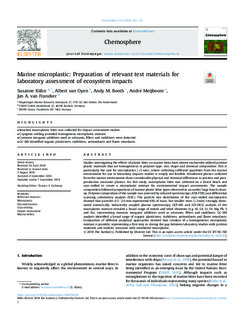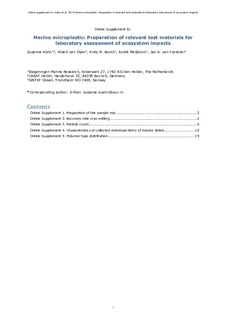| dc.contributor.author | Kühn, Susanne | |
| dc.contributor.author | van Oyen, Albert | |
| dc.contributor.author | Booth, Andy | |
| dc.contributor.author | Meijboom, André | |
| dc.contributor.author | van Franeker, Jan | |
| dc.date.accessioned | 2018-09-19T18:06:28Z | |
| dc.date.available | 2018-09-19T18:06:28Z | |
| dc.date.created | 2018-09-05T12:59:45Z | |
| dc.date.issued | 2018-12 | |
| dc.identifier.citation | Chemosphere. 2018, 213 103-113. | nb_NO |
| dc.identifier.issn | 0045-6535 | |
| dc.identifier.uri | http://hdl.handle.net/11250/2563528 | |
| dc.description.abstract | Studies investigating the effects of plastic litter on marine biota have almost exclusively utilised pristine plastic materials that are homogeneous in polymer type, size, shape and chemical composition. This is particularly the case for microplastics (< 5 mm), where collecting sufficient quantities from the marine environment for use in laboratory impacts studies is simply not feasible. Weathered plastics collected from the marine environment show considerable physical and chemical differences to pristine and post-production consumer plastics. For this study, macroplastic litter was collected on a Dutch beach and cryo-milled to create a microplastic mixture for environmental impact assessments. The sample composition followed proportions of marine plastic litter types observed in an earlier large beach clean-up. Polymer composition of the sample was assessed by infrared spectroscopy (ATR-FTIR) and differential scanning calorimetry analysis (DSC). The particle size distribution of the cryo-milled microplastics showed that particles 0.5-2.0 mm represented 68% of mass, but smaller sizes (< 2 mm) strongly dominated numerically. Inductively coupled plasma spectroscopy (ICP-MS and ICP-OES) analysis of the microplastic mixture revealed a broad range of metals and other elements (e.g. Al, Cd, Cr, Fe, Mg, Pb, S and Zn), representing common inorganic additives used as colorants, fillers and stabilisers. GC-MS analysis identified a broad range of organic plasticisers, stabilisers, antioxidants and flame retardants. Comparison of different analytical approaches showed that creation of a homogeneous microplastic mixture is possible, representing a first step in closing the gap between laboratory studies with pristine materials and realistic scenarios with weathered microplastic. | nb_NO |
| dc.description.abstract | Marine microplastic: Preparation of relevant test materials for laboratory assessment of ecosystem impacts | nb_NO |
| dc.description.sponsorship | Susanne Kühn is funded through the Joint Program Initiative (JPI) Oceans PLASTOX (Direct and indirect ecotoxicological impacts of microplastics on marine organisms) project by the Netherlands Organisation for Scientific Research (NWO) under the project number ALW-NWO 856.15.001. SINTEF Ocean was funded through the JPI Oceans project PLASTOX by Research Council of Norway (RCN; Grant Agreement number 257479/E40). The authors wish to thank the NWO and the RCN for their financial support. We are very grateful for the assistance in the labs provided by Markus Ortlieb (Shimadzu), Marianne Kjos and Lisbet Sørensen (SINTEF) as well as Andre Bouwmeester, Stephanie Westerhoff and Erwin Jansen (Carat GmbH). Two anonymous reviewers provided valuable comments to improve earlier versions of the manuscript. | nb_NO |
| dc.language.iso | eng | nb_NO |
| dc.publisher | Elsevier | nb_NO |
| dc.rights | Attribution-NonCommercial-NoDerivatives 4.0 Internasjonal | * |
| dc.rights.uri | http://creativecommons.org/licenses/by-nc-nd/4.0/deed.no | * |
| dc.subject | Reference material | nb_NO |
| dc.subject | Microplastic | nb_NO |
| dc.subject | Characterisation | nb_NO |
| dc.subject | Cryo-milling | nb_NO |
| dc.subject | Impact assessment | nb_NO |
| dc.subject | Marine debris | nb_NO |
| dc.title | Marine microplastic: Preparation of relevant test materials for laboratory assessment of ecosystem impacts | nb_NO |
| dc.title.alternative | Marine microplastic: Preparation of relevant test materials for laboratory assessment of ecosystem impacts | nb_NO |
| dc.type | Journal article | nb_NO |
| dc.type | Peer reviewed | nb_NO |
| dc.description.version | publishedVersion | nb_NO |
| dc.rights.holder | © 2018 The Author(s). Published by Elsevier Ltd. | nb_NO |
| dc.source.pagenumber | 103-113 | nb_NO |
| dc.source.volume | 213 | nb_NO |
| dc.source.journal | Chemosphere | nb_NO |
| dc.identifier.doi | 10.1016/j.chemosphere.2018.09.032 | |
| dc.identifier.cristin | 1606904 | |
| dc.relation.project | Norges forskningsråd: 257479 | nb_NO |
| cristin.unitcode | 7566,6,0,0 | |
| cristin.unitname | Miljø og nye ressurser | |
| cristin.ispublished | true | |
| cristin.fulltext | original | |
| cristin.qualitycode | 1 | |


